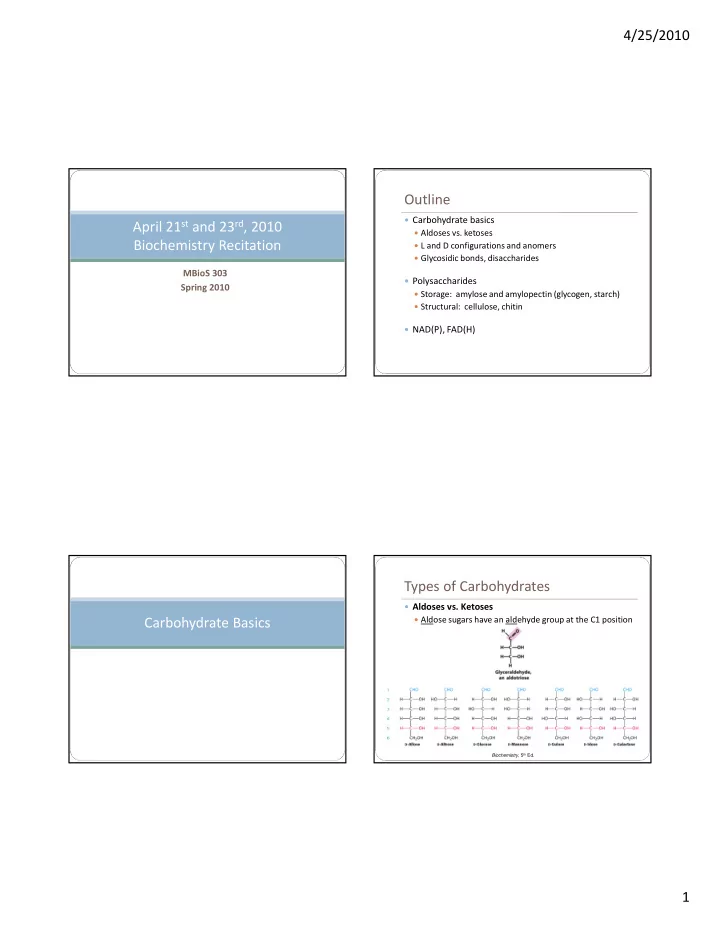

4/25/2010 Outline April 21 st and 23 rd , 2010 � Carbohydrate basics � Aldoses vs. ketoses Biochemistry Recitation � L and D configurations and anomers � Glycosidic bonds, disaccharides MBioS 303 � Polysaccharides Spring 2010 � Storage: amylose and amylopectin (glycogen, starch) � Structural: cellulose, chitin � NAD(P), FAD(H) Types of Carbohydrates � Aldoses vs. Ketoses Carbohydrate Basics � Aldose sugars have an aldehyde group at the C1 position Biochemistry , 5 th Ed. 1
4/25/2010 Types of Carbohydrates Carbohydrate Stereochemistry � Aldoses vs. Ketoses � Sugars can be in L or D configuration � Ketose sugars have a ketone group at any other position � Classified based on the chiral carbon farthest from carbonyl group � L or D designation referenced to that in glyceraldehyde � If the hydroxyl group at the farthest chiral carbon is on the left side in the Fischer projection, the sugar is in the L configuration � If the hydroxyl group at the farthest chiral carbon is on the right side in the Fischer projection, the sugar is in the D configuration Biochemistry , 5 th Ed. Carbohydrate Stereochemistry Carbohydrate Ring Formation (1) What type of sugar is glucose – an aldose or a ketose? (2) When forming a ring structure, what hydroxyl group acts as the nucleophile, and what carbon does it attack? CHO CHO What is the carbon numbering system? How do you know what side of the ring the substituents will be on? OH HO CH 2 OH CH 2 OH D-Glucose L-Glucose 2
4/25/2010 Anomeric Carbons L and D Configurations, Ring Structures D-Glucose L-Glucose CHO CHO How do you distinguish the � - anomer from the β- anomer? OH HO CH 2 OH CH 2 OH H CH 2 OH O OH H O H H CH 2 OH H H OH OH H H OH H O OH OH H H OH D-Glucose L-Glucose Glycosidic Bonds Glycosidic Bonds: Disaccharides � O-glycosidic bond: formed when hydroxyl on one sugar reacts with anomeric carbon on another sugar O-glycosidic bond What is unique about the structure of sucrose? 3
4/25/2010 Amylose: A Storage Polysaccharide � Amylose: Polysaccharides � Unbranched polymer of glucose monosaccharides � α 1 � 4 linkages ? Polymers of monosaccharides � One component of Linked by glycosidic bonds starch in plants Amylose: An Energy Storage Polysaccharide Amylopectin: An Energy Storage Polysaccharide � Amylose: � Amylopectin: � Unbranched polymer of � Branched polymer of glucose monosaccharides glucose � Branching approximately every 24-30 residues monosaccharides � α 1 � 4 linkages within one strand, α 1 � 6 branch points ? ? � α 1 � 4 linkages � Second component of starch in plants � One component of starch in plants Why might branching be useful? � α 1 � 4 linkages cause bending resulting in overall helical structure 4
4/25/2010 Amylopection versus Glycogen Glycogen: An Energy Storage Polysaccharide � Similar to amylopectin � Branched polymer of glucose monosaccharides � Branching approximately every 8- 12 residues � α 1 � 4 linkages within one ? strand, α 1 � 6 branch points ? � Energy storage in animals (mainly in liver cells) The Cell: A Molecular Approach , 2 nd Ed. http://en.wikipedia.org/wiki/Image:Glycogen.png Cellulose: A Structural Polysaccharide Cellulose: A Structural Polysaccharide � Unbranched polymer of glucose monosaccharides � Forms sheets � Stabilized by (1) hydrogen bonds, and (2) van der Waals � Found in plant cell walls interactions � β 1 � 4 linkages ? � Neighboring monosaccharides flipped 180⁰ relative to each other � Water insoluble – why?? What effect do the β1 � 4 glycosidic bonds have on the structure of cellulose? 5
4/25/2010 Cellulose: A Structural Polysaccharide Storage vs. Structural Polysaccharides � Most organisms cannot digest cellulose � No enzyme to break the β1 � 4 glycosidic bonds � This is what our “dietary fiber” is made up of The Cell: A Molecular Approach , 2 nd Ed. http://en.wikipedia.org/wiki/Image:CH_cow_2.jpg Chitin: A Structural Polysaccharide � Unbranched polymer of N -acetyl-D-glucosamine monomers Nucleotides � Found in many insect and arthropod exoskeletons, fungi cell walls, etc. � β 1 � 4 linkages ? � Confer properties similar to those of cellulose 6
4/25/2010 Nucleotides ATP N-glycosidic bond ADENINE RIBOSE PHOSPHATES NAD(P) + , FAD � NAD(P) + and FAD are electron carriers Electron Carriers � Can donate or accept electrons, depending on their oxidation state � This means they undergo redox reactions! � Electron donors can give electrons away, electron acceptors can accept additional electrons � Notation is important!! � NAD(P) + and FAD: they are in the oxidized state (can accept electrons) � NAD(P)H and FADH 2 are indicating that they are in the reduced state (can donate electrons) 7
4/25/2010 NAD + , NADH FAD, FADH 2 NIACIN Deficiency leads to RIBOFLAVIN Pellagra NAD+ compared to FAD QUIZ TIME! 8
Recommend
More recommend